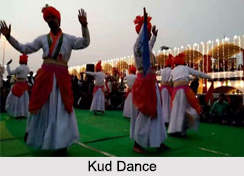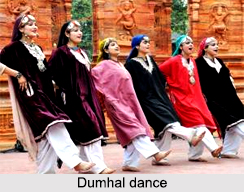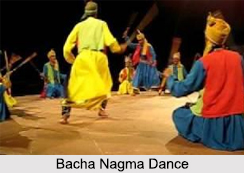 Kashmir is the north-western region of the Indian subcontinent, which is renowned for its natural beauty and quiet lifestyle. But apart from this, Kashmir also has its own share of festivities and glamour, when it comes to practising the folk dances. Kashmir"s folklore is deeply rooted in life of the local people and their passion is reflected in every performance ensuring that such ethos is not lost to future generations. Some of the unique folk dances of Kashmir are listed below.
Kashmir is the north-western region of the Indian subcontinent, which is renowned for its natural beauty and quiet lifestyle. But apart from this, Kashmir also has its own share of festivities and glamour, when it comes to practising the folk dances. Kashmir"s folklore is deeply rooted in life of the local people and their passion is reflected in every performance ensuring that such ethos is not lost to future generations. Some of the unique folk dances of Kashmir are listed below.
Bhand Jashan
A famous folk dance of Kashmir, Bhand Jashan is also popularly known as the Festival of Clowns. Its genre is of Kashmiri folk theatre and has been happening for the past 300-400 years. The traditional folk theatre style is a combination of play and dance in a satirical style. Thus, it mostly depicts parodies on social situations, expressing many strong sentiments through music, dance and clowning. This folk dance of Kashmir is usually performed in village squares, at many social and cultural functions in front of a large audience. The dance requires a group of 10 to 15 performers in their traditional style accompanied by musical instruments like the Surnai - a Kashmiri version of the Indian shehnai, big dhol, nagara, and peshrao. During the dance routine, all the performers put their hands on the waist of their co-partners and together move backward and forward with the light rhythm of the music. This folk dance of Kashmir seems to directly interact with the audience since it is all about conveying the tales from the political views to social aspects. The language used in the Bhand Jashan dance is not completely Kashmiri, but the combination of Hindi, Persian, Urdu and Punjabi depending on the subject of the dance chosen.
 Dumhal
Dumhal
Performed by the Rauf tribe, this famous folk dance of the Kashmiri people is called as Dumhal, performed on specific occasions and at set locations. Generally, this dance is performed by only the men folk of Wattal, wearing long colourful robes and tall conical caps, which are usually studded with beads and shells. Apart from dancing, the performers also sing in chorus, tuned with music by various drums. In this dance, groups of performers move in a ritual manner and dig a banner into the ground on various occasions. Usually, after which, the dance begins with men dancing around this banner.
Kud
It is a typical community dance, performed in the middle mountain ranges of the Jammu region. The Kud dance is one of the most popular folk dances of Kashmir and is performed during the rainy seasons. The dancers exhibit swaying & sinuous movements. It is basically a ritual dance performed in honour of the Lok Devatas and men, women and children, attired in their best, gather around a bonfire for this nightlong ritual. When the maize is harvested, the villagers gather and come down from the nearby hills in the vicinity of the local deity-the Gramdevta temple. The main motive behind these rituals is to express their gratitude for protecting their crops, cattle and children from natural calamities. Some special musical instruments are used in dance like chhaina, drums, narsingha and flute. Spontaneity is another key feature that is found mostly in all the folk dances of Kashmir. This kind of dance is generally performed in centre of mountains in and around Jammu and is mostly performed during rainy season.
People of all ages irrespective of their genders can participate in this folk dance form. Jammu has a rich heritage of folk dance and music, which are performed during ceremonies and social functions. Kud is also such a folk dance form performed to please Gods during nightlong soirees.
 Bacha Nagma
Bacha Nagma
Performed at cultural gatherings or special functions like weddings, this folk dance of Kashmir is only performed by boys. In this dance form of Bacha Nagma, it consists of maximum 6 to 7 members and one of the dancer is supposed to be the lead singer that sings in a melodious voice and the other members joins him in chorus. The young boys dress as women in long colourful skirts and they perform on the stage with a lot of grace. This dance had evolved a lot of years ago and has very well become a symbol of the culture among the Kashmiri communities. The Bacha Nagma dance is still very much recognized as a form of folk dance of Kashmir but with the availability of other forms of entertainment, the prevalence of the dance have minimized to a large extent.
Rouf
Another folk dance of Kashmir, Rouf originated in the Muslim community of the state of Kashmir and is mainly practiced by the women folk of the valley. The women are dressed in colourful costumes and stand in two rows facing each other. The dance primarily involves the use of footwork which is termed as Chakri in the local language. It is usually performed in all auspicious occasions and festivals and is particularly practiced in the spring season, especially during the harvest time when the weather is good. During the Ramzan month, the streets of Kashmir become pleasant with the help of Rouf songs and dance which are being performed by the Kashmiri women.
Hafiza
A popular folk dance of Kashmir, Hafiza dance is performed during wedding ceremonies particularly during Heena nights and when the groom walks into the bride"s house for the wedding. This form of dance is performed with Sufiana Kalaam form of music, it is a kind of music that relates to the Sufis and hence, its lyrics have got the Persian literary touch. Performed mainly by women, the instrument used for the rhythm and beat is the use of a santoor, which is played with the help of sticks.
Wuegi Nachun
This traditional Kashmiri folk dance is generally performed after all the rituals of wedding when the bride is about to leave her parental home. In this dance, Kashmiri pandit women dance around the bridal rangoli.
The folk dances and music of the Kashmir valley form an important part of the Kashmiri culture and these traditional dances are not only popular in this north-western state but also all over the country.



















